
- •Dry Cast Concrete
- •Wet Cast Concrete
- •Self-Compacting Concrete (SCC)
- •Sandwich Panel Construction
- •Precast Light Concrete
- •Precast Ultra Concrete
- •Types of Surface Finishes
- •Support and Fixings
- •Cost and Construction Matters
- •Glass Fibre Reinforced Concrete
- •Compact Reinforced Composite
- •Useful Contacts
- •Illustration Credits
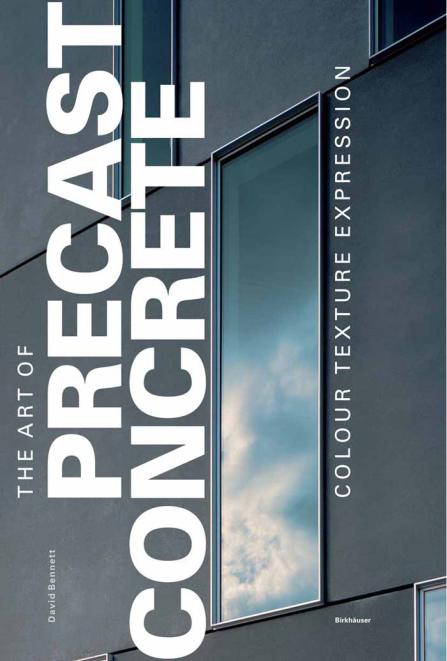

T H E A R T O F P R E C A S T C O N C R E T E
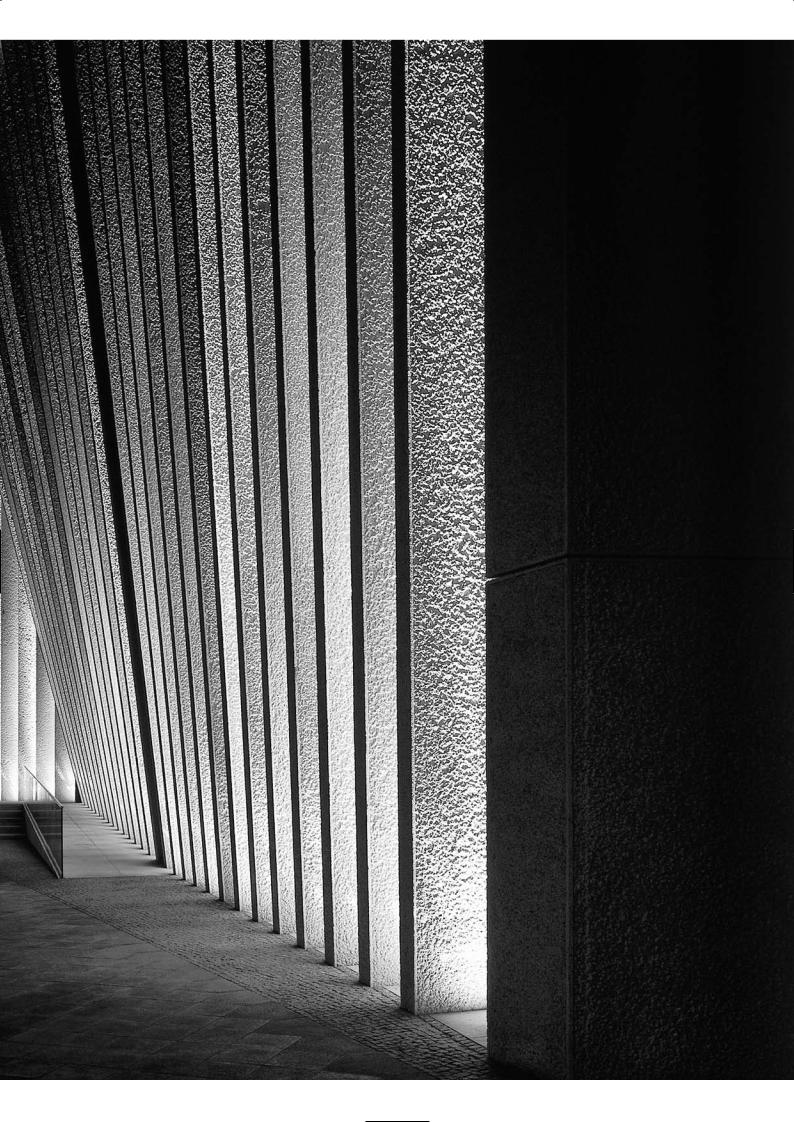

T H E A R T O F |
PRECAST CONCRETE C O L O U R T E X T U R E E X P R E S S I O N |
David Bennett
T H E A R T O F P R E C A S T C O N C R E T E
C O L O U R T E X T U R E E X P R E S S I O N
Birkhäuser – Publishers for Architecture
Basel · Berlin · Boston

We would like to thank the following institutions who kindly supported this publication:
Aalborg Portland, Aalborg, Denmark
Betongvaruindustrin, Danderyd, Sweden
Bundesverband der Deutschen Zementindustrie e.V., Berlin, Germany Lafarge, Paris, France
Rakennusteollisuus, Helsinki, Finland
The Concrete Centre, Camberley, England
Graphic design: Alexandra Zöller, Berlin
Parts of “Precast Materials and Methods of Manufacture” are derived from the essay “Cast Reconstructed Stone” written by David Bennett for the publication Christoph Mäckler (ed.),
Material Stone: Constructions and Technologies for Contemporary Architecture, Basel: Birkhäuser, 2004.
A CIP catalogue record for this book is available from the Library of Congress, Washington D.C., USA
Bibliographic information published by Die Deutsche Bibliothek Die Deutsche Bibliothek lists this publication in the Deutsche Nationalbibliografie; detailed bibliographic data is available in the internet at http://dnb.ddb.de.
This work is subject to copyright. All rights are reserved, whether the whole or part of the material is concerned, specifically the rights of translation, reprinting, re-use of illustrations, recitation, broadcasting, reproduction on microfilms or in other ways, and storage in data banks. For any kind of use, permission of the copyright owner must be obtained.
© 2005 Birkhäuser – Publishers for Architecture, P.O. Box 133, CH-4010 Basel, Switzerland
Part of Springer Science+Business Media
Printed on acid-free paper
produced from chlorine-free pulp. TCF
Printed in Germany
ISBN-13: 978-3-7643-7150-0
ISBN-10: 7643-7150-1
9 8 7 6 5 4 3 2 1
www.birkhauser.ch

C O N T E N T S |
|
Preface |
6 |
Precast Materials and Methods of Manufacture |
|
Dry Cast Concrete |
8 |
Wet Cast Concrete |
9 |
Self-Compacting Concrete (SCC) |
11 |
Sandwich Panel Construction |
11 |
Precast Light Concrete |
12 |
Precast Ultra Concrete |
14 |
Types of Surface Finishes |
17 |
Support and Fixings |
20 |
Cost and Construction Matters |
21 |
Denmark |
|
Spæncom Visitor Centre and Main Office, Aalborg |
24 |
Grammar School, Nærum |
28 |
SID Building, Århus |
34 |
United Exhibits Group Headquarters, Copenhagen |
40 |
Finland |
|
Main Building, University of Oulu |
44 |
Saterinrinne Housing Development, Helsinki |
50 |
Rastipuisto Apartment Block, Helsinki |
54 |
Mustakivi School and Community Centre, Helsinki |
60 |
France |
|
9 Avenue René Coty, Paris |
66 |
École Maternelle, Paris |
70 |
A16 Motorway Toll Booths, Picardy |
76 |
Germany |
|
Headquarters of Sozialverband Deutschland, Berlin |
80 |
Scharnhauser Park, Ostfildern |
86 |
Synagogue and Community Centre, Dresden |
90 |
Mexican Embassy, Berlin |
96 |
Great Britain |
|
10 Crown Place, London |
102 |
35 Homer Road, Solihull |
108 |
Experian Data Centre, Nottingham |
114 |
Scottish Parliament Building, Edinburgh |
120 |
Sweden |
|
Arlanda Control Tower, Stockholm |
126 |
Henry Dunkers Cultural Centre, Helsinborg |
130 |
Katson Building, Stockholm |
136 |
Geological and Geographic Sciences Building, Stockholm |
142 |
Glass Fibre Reinforced Concrete |
|
Stadtvilla Apartments, Kassel |
146 |
25-35 Park Lane, London |
148 |
Compact Reinforced Composite |
|
Spiral Staircase, Copenhagen |
152 |
Ductal® |
|
Seonyu Footbridge, Seoul |
156 |
Useful Contacts |
160 |
Illustration Credits |
|

P R E F A C E
The Brutalist period that followed the Modern Movement era, where cast in place concrete was used to excess, led to decades of mistrust and rejection of its architectural merit as the rust stained, grey-black, pock marked surfaces were laid bare for all to witness. Precast concrete up to that time was largely specified for making reconstructed stone panels, paving slabs and decorative features. Now it was used as the replacement for cast in place concrete in many European countries, ensuring the integrity of surface appearance with off-site manufacture. Precast concrete’s popularity grew, the product range increased and many new precast companies started up. Colour, surface texture, light and shade profiling and bas relief effects plus plasticity of form and large panel construction gave architects a design freedom that was not possible with cast in place concrete.
Better material understanding, researches into surface durability, improved standards of manufacture and production continues to position precast concrete as the premier product for surface appearance in Northern Europe but it comes with a warning. It can be prohibitively expensive in some countries and is not always a popular choice.
In today’s building markets, reflected by its share of the architectural cladding market, popularity of precast concrete varies dramatically across Europe. In the UK for example it is considered the most expensive, heavy-weight cladding option for a façade. Its market share is less than 2% of the cladding market. In Finland precast concrete takes 33% of the total building market and is the most dominant material for cladding multi-storey residential buildings (97%) because it is the cheapest and most efficient method of construction. Precast market situations in Sweden and Denmark echo the trend in Finland.
In researching the material for this book this startling difference in market share became all too transparent. Market share is higher where the price of precast cladding panels is low or competitive with alternatives – that is obvious. What is not are the reasons for these big differences.
In Finland to keep precast prices competitive architects and specifiers must choose standard products from manufacturer catalogues. To do otherwise would incur large surcharges of up to 300% for bespoke production. The design of precast structural and façade elements is carried out by structural engineers and architects working to guidelines given in the precast product literature. The precast manufacturer concentrates solely on the production and supply of units to the site. They use flat bed casting methods that are semi-automated and highly mechanised, employing the minimum of labour to keep costs down. The precast prices are based on high volumes and standardisation of the product range. They are not involved in the site assembly and erection of precast units. That is carried out by the main contractor who is familiar with precast composite construction. The preferred choice of construction of residential buildings in Finland is precast floor planks with precast load-bearing façade panels. When looking at residential architecture in Finland you become aware of the similarity of composition, the standardisation of façade panel construction and how creative architects can be within these tight parameters: a very compelling argument that good design need not be expensive.
6

By contrast the architectural cladding market in the UK is the total opposite. There is no standardisation of façade elements industrywide or from one project to the next. Architects and designers are free to scheme their layouts, unique to their own project. They are encouraged to use the same panel unit and assembly arrangement to reduce the cost of mould making, but that is often not possible. The façade units are designed by the precast company who usually erect and assemble the units as a total supply and install package. Consequently the precast company will carry a lot more overheads and risk. By encouraging bespoke, nonstandard units to be specified, they attract a much higher price in production. Each precast company will have their own connection detail and fixing arrangements. As a result we see exuberance, expressive and flamboyant architecture that comes at a price premium, but there are examples where restraint and rigour has given a fine quality to the structure. They all have one thing in common – they are all different and that perhaps is the telling attraction and appeal of British precast architecture.
As a result of these divergent market conditions, the architecture will differ in scope and aspirations from one country to the next. Precast design reflects the economic constraints on local production as much as the self-conscious attempts by architects to imbue artistic endeavour, context, creative inspiration and ordered formality into the functional purpose of a building. This collection of projects from Sweden, Denmark, Finland, France, Germany, Scotland and England shows how precast concrete in all its different forms, modes and finishes can be brought together creatively and thoughtfully. Some make use of bold vibrant colours and shapes, some draw expression from restraint and tautness of standardised components, while others show how light-weight glass fibre reinforced concrete and the new ultra high strength precast CRC and Ductal® products offer new possibilities in precast architecture.
Each project has been reviewed as a case study with illustrations and descriptions on how it was designed and built and how the precast elements were specified. While the examples are not a definitive list, they have been recognised for their excellence of concrete expression. The section on materials and methods will provide the reader with information on the many different ways to precast concrete and the many choices of surface finish, texture and profiling that are possible.
I am indebted to all the architects and precast manufacturers who gave up their time to share their knowledge with me. I wish to thank those organisations and individuals who helped to make the research to this book possible by arranging my visits to each country. They are BDZ and Jörg Fehlhaber in Berlin, Betongvaruindustrin and Lena Frick in Stockholm, Aalborg White and Hans Bruun Nissan in Denmark, Lafarge Ductal® and Mouloud Behloul in Paris and The Confederation of Finnish Construction Industries RT and Arto Suikka in Helsinki. I also thank Martin Clarke of British Precast for his helpful contacts in Europe and Ian Cox and his team at The Concrete Centre for supporting the book in the UK.
I have learnt so much about precast from researching this book. I hope it brings enlightenment and interest to designers who share an enthusiasm for concrete and perhaps converts one or two sceptics to take a closer look at precast architecture in all it forms. The new ultra high strength materials are sensational.
This book is dedicated to my editor Ria Stein at Birkhäuser who without fuss, formality and bother brings the chaotic and piecemeal arrival of text and images into a coherent, structured and concise work that is then skilfully designed by Alexandra Zöller. Cheers to you both and heartfelt thanks!
David Bennett
7
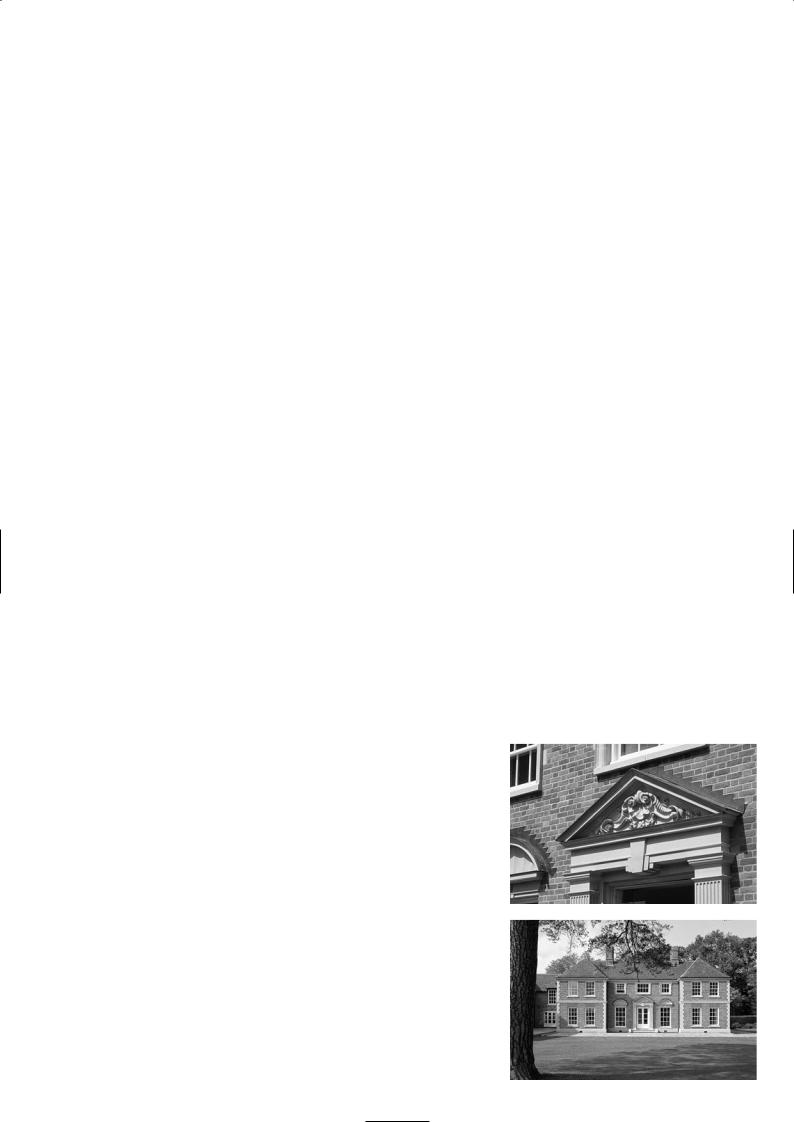
P R E C A S T M AT E R I A L S A N D M E T H O D S O F M A N U F A C T U R E
Concrete has been a very versatile and durable material for replicating natural stone for over a century. The increasing scarcity of natural stone and the great expense of cutting and transporting it, has opened up a worldwide market for the production of reconstructed stone and precast concrete using cement as the binder. Fine dust matched to the colour and texture of natural stone is combined in a matrix of fine aggregates, cement and pigments and placed in moulds to form stone-like facing panels, slabs and decorative detailing. In the early years reconstructed or cast stone was processed by the moist-earth or dry cast method where the mix was made semi-dry with low water content and consolidated in timber moulds by ramming or tamping. Modern dry cast stone has a higher porosity than wet cast methods and lower strength, and this tends to limit production to relatively small unit sizes. This method is still used successfully today to replicate both simple and intricate details including ashlar walling, quoins, cornices, sills, string courses and columns on buildings.
The more sophisticated wet cast method of production commonly referred to as precast concrete and the focus of this book, uses very workable, fluid mixes of aggregates, cement and pigments and water. The fluid mix is poured into grout-tight moulds or formwork and compacted by internal and external mechanical vibration and allowed to harden. Precast concrete has high strength, low porosity, low moisture absorption and greater durability. Its fluid consistency allows it to be moulded into complex and intricate shapes. It can be fully reinforced to form large storey-high panels that can be crane-handled, making site installation fast and less labour intensive.
Precast concrete as a structural engineered stone offers new possibilities in expressing the intrinsic qualities of the raw materials – cement, aggregates and pigment. Here the material’s plastic form, the choice and range of colours, combined with surface texturing and profiling gives scope and great opportunity to design with freedom and imagination. The surface can be finished with an acid-etch, grit blast, mechanical abrasion or diamond polishing to give it a terrazzolike appearance.
For integrating precast with high-tech curtain wall systems, the dead weight of the panel can be reduced significantly by specifying light-weight glass fibre reinforced concrete known as GRC. The material is cast in moulds in exactly the same way as precast concrete except that it is reinforced with alkali-resistant glass fibre strands – there is no steel reinforcement – and it can poured in place or spray-applied in layers. GRC panels are easy to handle, they do not require heavy cranage on site and can be installed using a cradle system, they are resilient and do not corrode.
The use of recently developed ultra-high performance concrete in the manufacture of precast concrete offers radically new and dramatically slender structural possibilities in concrete. Two innovations in the ultra-high performance materials have shown how these products can be used to form architectural elements, balcony slabs, staircases and bridge structures that outperform conventional concrete structures and can compete with steel for slenderness.
Dry Cast Concrete
This technique dates back to Roman times where a mixture of lime and pozzolanic cement, sandstone fines and aggregates was made with just enough moisture to hold it together without crumbling. The semi-dry mix was rammed into wooden moulds and left to harden. It was used for making simulated sandstone lintels and for repairing stonework. An example of this can be seen in repair of the Visigoth walls at Carcassonne in south-west France, built in AD 1135.
With the discovery and commercial development of Portland cement in the last century, the dry cast method of producing cast stone was used extensively in the manufacture of artificial stone blocks and facings. It was employed to imitate with great economy, the natural Portland and Bath stone façades of classical Georgian buildings for example and later modelled for Art Deco and Neo-Classical architectural styles. The cast block can be sometimes carved while still green to decorate and sculpture the surface, although such detailing would usually be incorporated in the mould. Cast stone is formed with a semi-dry facing layer comprising a mixture of crushed stone and cement, backed with an ordinary semi-dry concrete layer, which can incorporate reinforcement for strengthening load-bearing elements.
Top: Pediment over doorway (dry cast)
Bottom: Precast quoins corner and decorative features on Shillington Manor, England (dry cast)
8
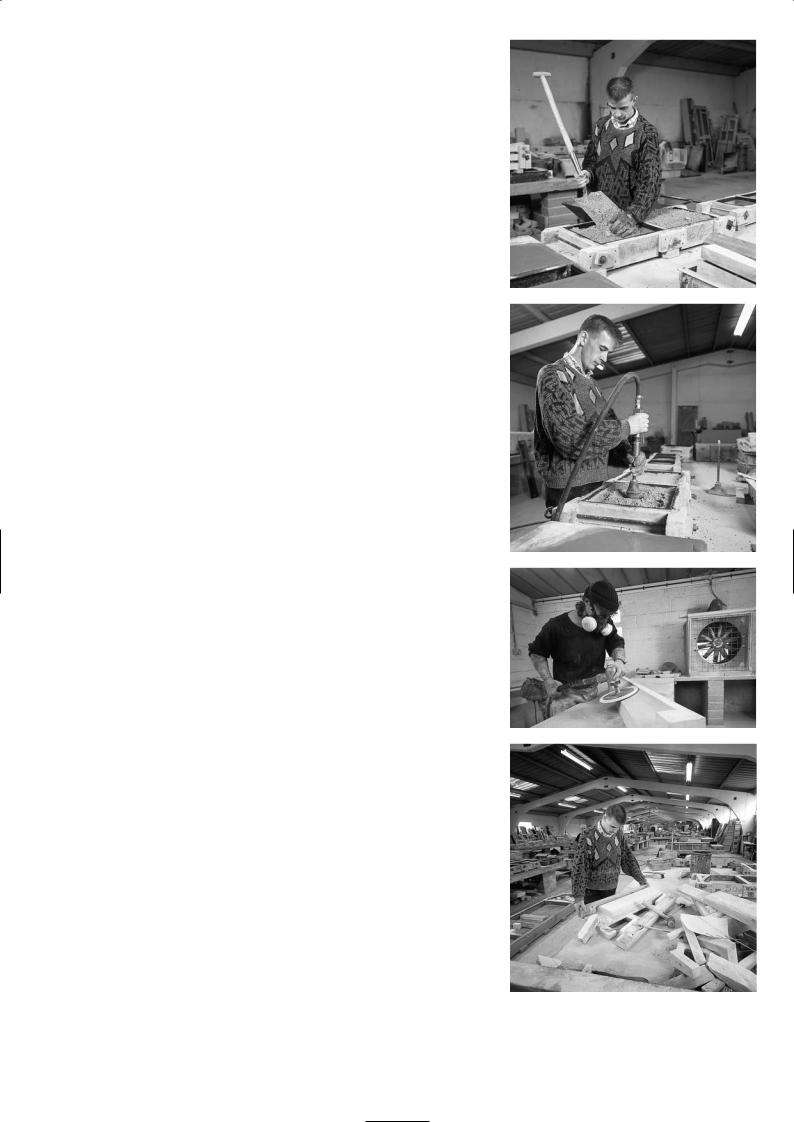
The timber mould for forming the cast stone is filled with a 40mm layer of the facing mix which is tamped with an air powered hammer to fully compress the material in the mould. The surface is lightly scratched to ensure an adequate key for the backing concrete which follows in layers of 50mm and is similarly consolidated. Small man-handled pieces which are simple in shape and generally 75mm thick can be de-moulded immediately after the mix has been rammed. The rammed concrete is firm enough to be turned out of the mould without damage. This makes the dry cast method very cost-effective, as one mould can turn out many units per hour. Where delicate ornamental shapes and deep surface profiles are required, a more homogenous cement-rich mix is used and the concrete left to cure in the mould for 24 hours.
Current methods of production are considerably more advanced than the techniques used in the middle of the last century. There are two different production techniques – the first of which is suited to high volume production of small manhandled units. Here the moulds are immediately turned out once they have been filled. The second method which results in far higher quality and detail requires the concrete to be left in the mould overnight before removal. This technique is more commonly used for casting columns, balustrades and architraves and in ornamental landscape artefacts.
Both methods require vapour curing to achieve their optimum strength. The dry cast mix when compressed in the hand will hold together without crumbling and not leave an excessive residue on the hand. The mix of cement and pigment will include very fine crushed natural stone aggregate which has been selected for stone replication, and incorporate a waterproofing admixture such as aluminium stearate, calcium stearate or an acrylic emulsion, to reduce porosity. Most mixes contain coarse aggregates that are generally 3mm in diameter and rarely more than 6mm. Inorganic pigments are used extensively and blended in with either grey or white cement at proportions between 2% to 6% by weight of cement.
Dry cast units will usually require no further surface treatment. Corners and arrises which can be friable should be fully vapour cured. If they get damaged during handling, they should be repaired at the earliest opportunity. The hardened surface can be grit blasted, acid-etched, tooled and traditionally carved. Fixing and detailing of earth-moist units is the same as for natural masonry construction.
Wet Cast Concrete
Increasing mechanisation in construction, the use of the tower crane, the high cost of labour and the need to build quickly created the demand for prefabricated building components and of course large precast façade panels. To form large modern precast panels economically, the concrete mix must have a liquid consistency that will allow it to flow into the moulds without segregating and combine with the reinforcement bars to produce a durable self-supporting structure
– hence the term wet cast production
Wet cast concrete, also known as conventional precast, will have a high cement content as it requires a higher water content to create workable, flowing mixes. The proportion and combination of sand, coarse aggregates (up to 20mm in size), cement and pigments will be selected to give the desired finish and will be based on many years experience of precast production. The concrete mix will include the use of water-reducing admixtures and water-proofing agents. It will have been tested for compatibility with the mould oil and formwork face to ensure no adverse effects will arise due to tannins and sugars in the wood, crazing from smooth polished surfaces or staining from release agents.
When the mix is placed in the mould it has to be consolidated using internal and external vibration to remove entrapped air voids and draw the pigment and cement particles to the exposed surface. It is essential that the moulds are made watertight as any leakage of the cement and pigment will leave an unsightly discolouration and honeycombing. In relatively small moulds it may only be necessary to rebate or groove the sides and end of the moulds before they are clamped tight. Larger moulds may need foam gaskets at critical joints or neoprene
barriers to prevent grout loss.
Dry cast production
Some manufacturers of modern precast concrete prefer to use resin faced plywood or GRP (glass fibre reinforced plastic) lined timber for constructing the moulds. Others will use metal forms because of the high re-use factor for the casting of standardised products. For surface profiling and embossing decorative features, GRP and synthetic rubber liners are placed in the timber moulds. Steel
9
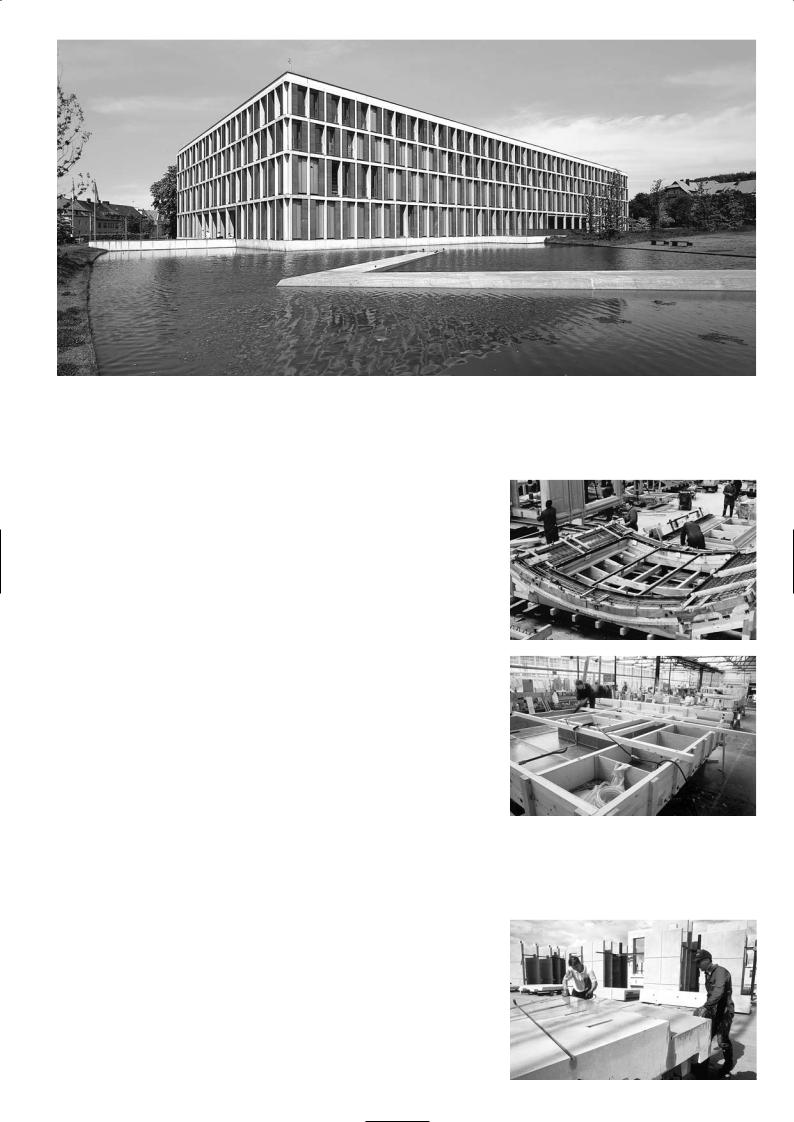
moulds can be ideal for casting very large units although they tend to produce a much darker finish with a shiny surface. They cost many times more than the equivalent timber moulds but are capable of being used several hundred times.
The precast moulds are laid flat during concreting; the top face (the reverse side of the panel) is left exposed to be trowelled level after the concrete has been vibrated. This is called flat-bed construction and it is how most precast panels are formed. Sometimes the mould is cast in the vertical position and formwork has to be secured and braced with wailings, props and ties to ensure that it remains rigid and watertight. Such a construction method is specified when the surface has to be heavily grit blasted or point tooled but is more expensive as more formwork materials are required.
The concrete is left in the moulds for at least 18-24 hours to cure and harden before the formwork can be stripped. For economic production, the moulds should have at least 30 uses before being discarded. It is rare to find a building which has 30 or more identical units on the façade. To mitigate the penalty of low repetition, façade panels should be designed as similar shaped units which can be cast from one master mould. Major economising in production cost can be achieved by making small alterations to the master mould.
When the concrete panel is removed from the mould, the facing surface is immediately rubbed down to remove any mould oil stains and surface blemishes and then left to fully harden before further surface treatment is carried out. Occasionally the surface is washed with a cement-pigment paste to fill any air holes and to homogenise the surface appearance. Precast concrete can be finished in a number of different ways which includes acid-etching, applying retarder and water jetting, surface rubbing, sand and grit blasting, bush hammering, point tooling and polishing with diamond or carborundum discs to give a very smooth surface finish.
The maximum panel size that can be precast is governed by two factors: the dimensions of the façade opening and the maximum length and width that can be transported on a lorry. In the UK this is 12m long by 5m wide by 4.1m high for a lorry travelling on a motorway with police escort. If the width is restricted to 2.89m such a load can travel on any road in the UK without police notification.
Thermal insulation can either be fixed to the back of the unit on site after the panel is installed or factory applied. Composite precast sandwich panels with thermal insulation in the core are manufactured in some European countries, where the problems of cold bridging have been overcome by the use of proprietary anchors.
Large precast panels are usually formed with an integral nib which sits on the supporting floor slab or beam, with the top of the panel pinned to the main structure to allow for differential movement. Joints between panels are sealed using silicone or polysulphide sealants.
Precision and scale of modern precast design (Federal Labour Court, Erfurt, Germany)
Mould for curved panel being bolted together
Forming timber master mould
Light acid washing
10
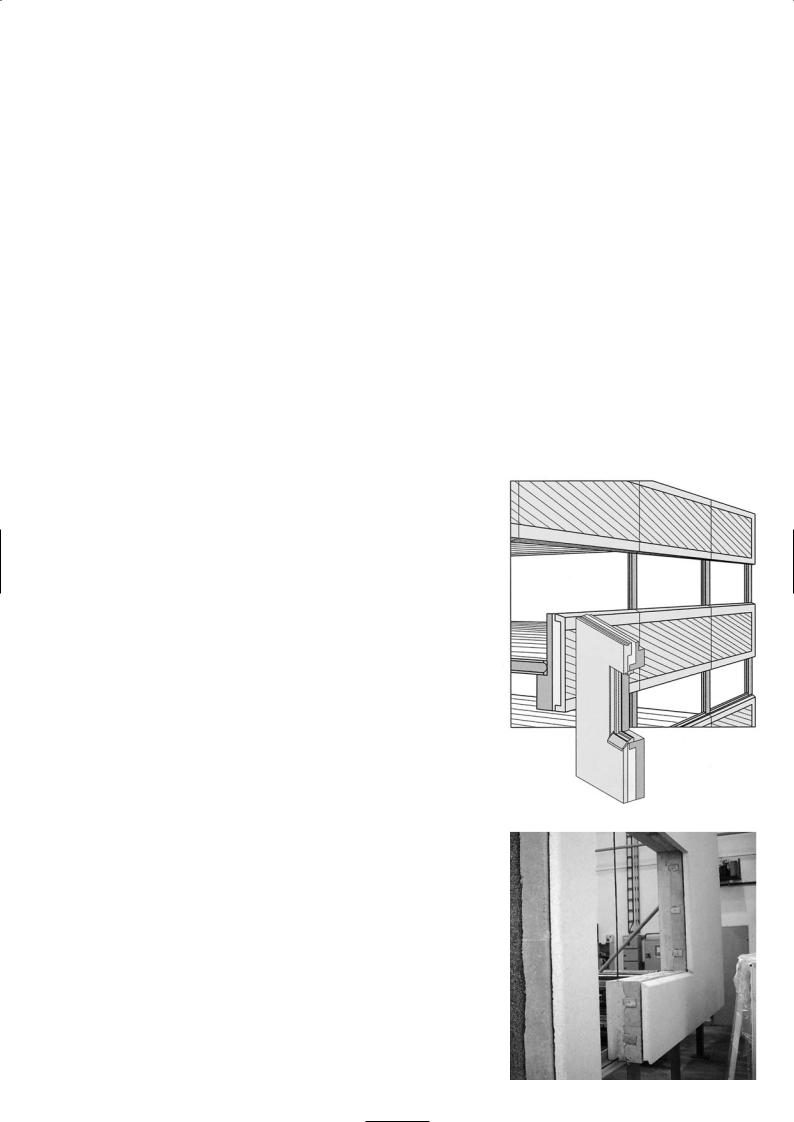
Self-Compacting Concrete (SCC)
Where difficult vertical sections of precast are required with very congested reinforcement, then a self-compacting concrete is often specified. For example the massive charcoal grey free-standing precast blocks for the Jewish Memorial in Berlin designed by Eisenman Architects – up to 3m high and weighing up to 20 tonnes – have been cast with pigmented self-compacting concrete.
Self-compacting high performance concrete minimises air voids induced during the placing process and those formed because of the excess water required for workability with normal compacted concrete.
By introducing a viscosity agent in the mix, the viscosity of the concrete paste can be increased effectively to inhibit segregation. For practical necessity, the proportion of fine to coarse aggregates is kept at 1:1 by volume. If the coarse aggregates exceed a certain limit, there is greater contact between the larger particles which increases interlocking and the risk of blockages on passing through spaces between reinforcing bars. The possibility of interlocking is negligible if the solid content of the coarse aggregate fraction is lower than 50% of the total mix, provided adequate mortar is used. Smooth, rounded river gravels are generally preferred because this permits a larger coarse aggregate volume than an angular or rough textured one.
Fine aggregate is defined as particles that are larger than 90 microns, anything smaller is defined as powder. The amount of water confined by the fine aggregate is almost proportional to the volume of fine aggregate, so long as the fine aggregate proportion is around 20%. Selection of the powder is critical because the properties effect self-compaction and govern the quality of the hardened concrete. SCC mixes contain higher than normal proportions of fine material that are smaller than 90 microns such as pfa (pulverised fuel ash), ggbs (ground granulated blast furnace slag) or limestone powder. One of the characteristic features of a powder is that a unit volume confines a large amount of water. There is an optimum water/powder ratio for imparting viscosity to the mortar paste for self-compacting concrete.
Properties of hardened SCC do not differ significantly from those of ordinary concrete of a similar basic composition. For compressive strength compliance the standard concrete cube test will be adequate. The extra cost of the higher cement content and special admixtures can be justified by the greater savings on the labour and time consuming activity of vibrating concrete. The elimination of compaction opens up the opportunity for greater concrete automation into the production process.
Sandwich Panel Construction
One of the most structurally efficient precast options is sandwich panel construction. The panels are storey-high units up to 8m long with an outer façade panel of between 60mm and 80mm thick that can be finished with a wide range of surfaces; a layer of insulation and then a backing leaf of either load-bearing or self-bearing precast concrete between 90mm and 120mm thick. Self-bearing means that the sandwich panels can only support their own weight. When the inner leaf is load-bearing it can support the structural floor and the façade above it.
The structural floors are usually precast hollow core planks that are stitched to the top of the inner panel. The load-bearing sandwich panel offers many advantages. They are fast to erect, they eliminate the need for columns and wet trades, they are self-finished and the most competitively priced residential building system in Europe.
The two layers of the panel are interconnected by steel ladder reinforcement which act as wind and shear connectors. The thermal bridge through the steel connectors is minimal. The system has the advantage of providing structural integrity without placing any reliance on the insulation for load transference.
Sandwich panel details: outer leaf decorative, insulation layer and load-bearing inner leaf
Typical sandwich panel construction
11
